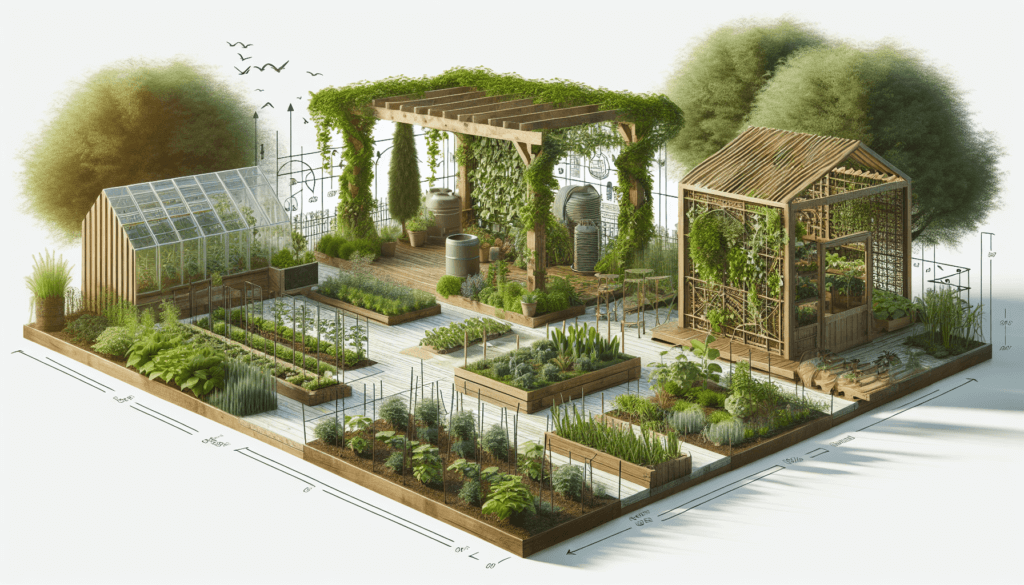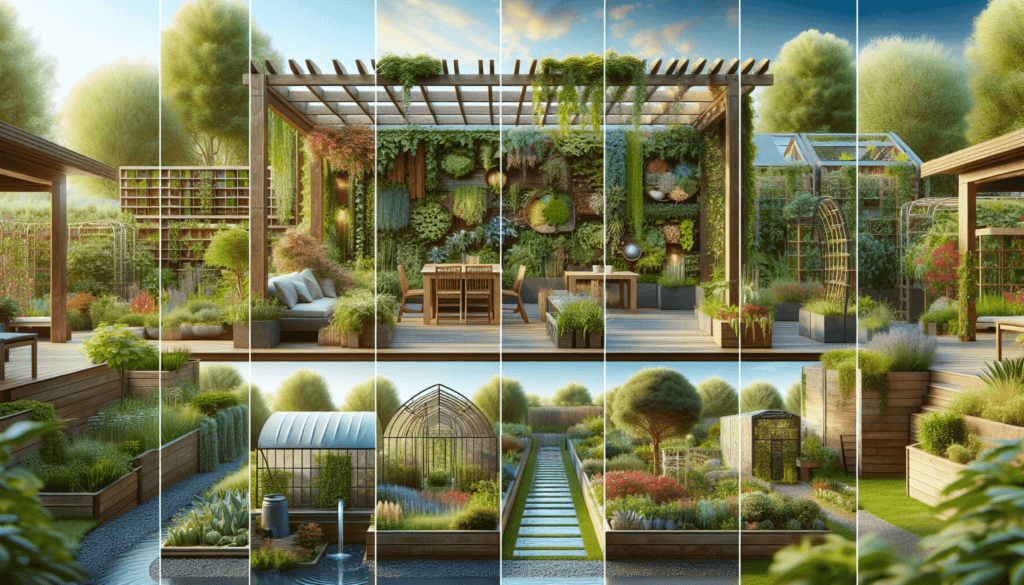If you’re looking to enhance the beauty and environmental impact of your garden, incorporating sustainable garden structures is the way to go. By adding structures such as green roofs, rainwater harvesting systems, and compost bins, you can create an eco-friendly oasis that not only looks stunning, but also supports sustainability. Whether you’re a passionate gardener or simply enjoy spending time outdoors, these structures are a fantastic addition that will transform your garden into a sustainable haven.

1. Benefits of Sustainable Garden Structures
1.1 Environmental Benefits
Sustainable garden structures offer a myriad of environmental benefits. By incorporating these structures into your garden, you are contributing to the preservation and protection of the environment. For instance, greenhouses are known for their energy efficiency and ability to regulate temperature, allowing for year-round cultivation of plants. This reduces the need for importing produce from distant locations, thereby reducing carbon emissions from transportation.
Moreover, garden structures such as pergolas and trellises provide shade and can help cool down the surrounding areas, reducing the need for excessive air conditioning. They also act as windbreakers, protecting delicate plants from harsh winds. Additionally, rainwater harvesting systems collect and utilize rainwater, reducing the dependence on freshwater sources and conserving this precious resource.
1.2 Economic Benefits
In addition to the environmental advantages, sustainable garden structures can also yield economic benefits. These structures can help you save money in the long run by reducing utility costs. For example, incorporating greenhouses into your garden allows you to grow your own fruits, vegetables, and herbs, saving you from purchasing them at high prices from stores. Furthermore, rainwater harvesting systems can significantly reduce water bills, as you will be utilizing free rainwater instead of relying solely on municipally supplied water.
Moreover, sustainable garden structures add value to your property. These structures enhance the aesthetic appeal and functionality of your garden, making it a desirable feature for potential buyers. Therefore, investment in sustainable garden structures can provide a significant return on investment when it comes time to sell your property.
1.3 Health Benefits
Sustainable garden structures also offer numerous health benefits. Spending time in a garden environment has been proven to reduce stress levels and improve mental well-being. These structures provide an inviting space to relax, rejuvenate, and connect with nature. The fresh air and greenery contribute to a calm and peaceful ambiance, promoting overall physical and mental health.
Additionally, growing your own food in a greenhouse or garden can lead to a healthier and more nutritious diet. You have control over the types of pesticides and fertilizers used, ensuring that your produce is free from harmful chemicals. It also encourages physical activity and provides an opportunity for people of all ages to engage in gardening, which has been shown to have therapeutic effects on both physical and mental health.
2. Types of Sustainable Garden Structures
2.1 Greenhouses
Greenhouses are enclosed structures designed to provide optimal growing conditions for plants. They are typically made of transparent materials such as glass or polycarbonate panels that allow sunlight to penetrate while trapping heat. Greenhouses extend the growing season and protect plants from harsh weather conditions, pests, and diseases. These structures can be built in various sizes and styles, ranging from small backyard hobby greenhouses to large-scale commercial facilities.
2.2 Pergolas
Pergolas are outdoor structures with cross beams and an open roof that provide partial shade and a focal point in the garden. They are commonly constructed using vertical posts and horizontal beams, often made of wood or metal. Pergolas not only add visual interest but also offer a shaded area to relax or entertain guests. They can be adorned with climbing plants such as vines or flowers, adding a touch of natural beauty to the structure.
2.3 Trellises
Trellises are vertical structures made of lattice or grid-like panels, usually crafted from wood or metal. They are used to support and train climbing plants, allowing them to grow vertically. Trellises are versatile garden structures that can be freestanding or attached to walls and fences. They provide an efficient use of space, allowing plants to grow upward and saving ground space. Trellises can be utilized to create privacy screens, decorate walls, or divide outdoor spaces.
2.4 Rainwater Harvesting Systems
Rainwater harvesting systems collect rainwater from rooftops, gutters, or other surfaces and store it for later use in the garden. These systems typically consist of rain barrels, cisterns, or underground tanks to capture and store the water. Rainwater can be used for various purposes, such as irrigation, watering plants, or even for washing outdoor surfaces. Installing rainwater harvesting systems not only reduces the need for potable water but also prevents excess stormwater runoff, which can contribute to soil erosion and water pollution.
3. Materials for Sustainable Garden Structures
3.1 Reclaimed Wood
Using reclaimed wood for garden structures is an environmentally friendly option that reduces the demand for new timber. Reclaimed wood is salvaged from old buildings, barns, or other sources and given a new life in garden projects. It adds character and charm to the structures and can be customized to fit various design styles. Reclaimed wood is a durable and long-lasting material that can withstand outdoor conditions while minimizing the carbon footprint.
3.2 Bamboo
Bamboo is a sustainable and renewable material that is gaining popularity in garden structures. It is a fast-growing plant and can be harvested without killing the entire plant, making it an eco-friendly choice. Bamboo is lightweight yet strong, making it suitable for constructing pergolas, trellises, and other garden structures. It exudes a natural beauty and warmth that enhances the aesthetics of any garden.
3.3 Recycled Plastic
Recycled plastic is an excellent alternative to traditional materials in sustainable garden structures. It is made from post-consumer plastic waste, such as plastic bottles and packaging, that would otherwise end up in landfills or oceans. Recycled plastic is durable, resistant to decay, and requires minimal maintenance. It can be molded into various shapes and sizes, offering endless possibilities for creating unique and functional garden structures.
4. Design Considerations for Sustainable Garden Structures
4.1 Integration with the Landscape
When designing sustainable garden structures, it is essential to consider how they will blend harmoniously with the existing landscape. The structures should complement the natural surroundings and enhance the overall aesthetics of the garden. Taking into account the size, shape, and color palette of the garden will ensure a cohesive and visually pleasing design.
4.2 Functionality and Versatility
Sustainable garden structures should not only be visually appealing but also serve a functional purpose. Consider your specific needs and requirements when selecting or designing a structure. For example, pergolas can be designed to provide shade during hot summer months or be equipped with retractable canopies for protection from rain. Trellises can be used to create privacy screens or divide different areas of the garden. The versatility of these structures allows for flexibility in their usage.
4.3 Utilizing Renewable Energy
Another crucial design consideration for sustainable garden structures is the integration of renewable energy sources. For instance, incorporating solar panels on the roof of a greenhouse can provide power for lighting, heating, or ventilation systems. This reduces dependence on conventional energy sources and further enhances the sustainability of the garden structures.

5. DIY Sustainable Garden Structures
5.1 Building a Greenhouse from Salvaged Materials
Building a greenhouse from salvaged materials is a cost-effective and sustainable option for avid gardeners. Look for discarded windows, glass panels, or old wooden frames that can be repurposed for your greenhouse. By utilizing reclaimed materials, you not only reduce waste but also give a new life to items that would otherwise end up in a landfill.
5.2 Constructing a Pergola with Recycled Wood
Constructing a pergola with recycled wood is an excellent DIY project that adds a rustic charm to your garden. Search for discarded pallets, old fences, or salvaged timber that can be transformed into a stunning pergola. Be sure to properly treat and waterproof the wood to ensure its longevity and resistance to outdoor elements.
5.3 Creating a Rainwater Harvesting System
Creating a rainwater harvesting system is a simple and rewarding DIY project that helps conserve water. Install rain barrels or cisterns at the downspouts of your gutters to collect rainwater. Attach a spigot to the barrels for easy access to the stored water. You can use this collected rainwater to irrigate your garden, reducing your reliance on municipal water.
6. Professional Installation and Maintenance
6.1 Hiring a Landscape Architect or Designer
For those who prefer a professionally designed and installed sustainable garden structure, hiring a landscape architect or designer is recommended. These professionals have the expertise to create a cohesive and functional design that suits your specific needs. They can help select the right materials, plan the layout, and ensure that the structure complements your overall landscaping.
6.2 Consulting with a Sustainable Gardening Expert
Consulting with a sustainable gardening expert can provide valuable insights and guidance throughout the installation process. They can recommend the best sustainable garden structures for your specific climate and garden conditions. They can also provide advice on maintenance and care to ensure the longevity of your structures.
6.3 Regular Maintenance and Upkeep
Regular maintenance and upkeep are essential for the longevity and functionality of sustainable garden structures. Follow the manufacturer’s guidelines for cleaning, sealing, and treating the materials used in your structures. Regularly inspect for any damage, wear, or decay, and address any issues promptly to prevent further damage. By properly maintaining your garden structures, you can enjoy their benefits for years to come.

7. Examples of Sustainable Garden Structures
7.1 Inspirational Greenhouse Designs
Inspirational greenhouse designs showcase the creativity and innovation in sustainable gardening. From traditional glass-paneled structures to modern geodesic domes, there are countless designs to inspire your own greenhouse project. Explore various styles, sizes, and materials used in these designs to find inspiration that aligns with your vision and garden space.
7.2 Creative Pergola Adaptations
Creative pergola adaptations demonstrate how these structures can be customized to suit individual preferences and needs. From incorporating retractable canopies for shade and rain protection to adding built-in seating or outdoor kitchens, there are endless possibilities to enhance the functionality and aesthetics of pergolas. These examples will inspire you to think outside the box and create a truly unique pergola design.
7.3 Innovative Trellis Installations
Innovative trellis installations showcase the versatility of these structures and inspire creative ways to utilize them in your garden. From creating living walls covered in cascading flowers to using trellises as privacy screens or space dividers, there are numerous ways to incorporate trellises into your garden design. Explore these examples for inspiration on how to maximize the use of trellises in your outdoor space.
8. Incorporating Sustainable Garden Structures in Small Spaces
8.1 Vertical Gardening with Trellises
In small spaces, utilizing vertical gardening techniques with trellises is a fantastic way to maximize growing area. By training plants to grow vertically, you can create a lush and productive garden in limited space. Trellises can be attached to walls, fences, or even freestanding structures, providing opportunities for growing climbers, vining vegetables, and decorative plants.
8.2 Miniature Greenhouses for Apartment Balconies
Even in the smallest of spaces, it is possible to incorporate miniature greenhouses on apartment balconies. These scaled-down versions of traditional greenhouses are designed to fit on balconies or small patios. They provide a controlled environment for growing a variety of plants, including herbs, vegetables, and even small fruit trees. Miniature greenhouses allow apartment dwellers to enjoy the benefits of sustainable gardening on a smaller scale.
8.3 Space-Saving Pergola Designs
Space-saving pergola designs are perfect for smaller gardens or urban spaces. These designs focus on maximizing the functionality of the pergola while minimizing the footprint. Installing a pergola that integrates seating or storage solutions, or even multi-level platforms, allows you to make the most of the available space. These designs provide both aesthetic appeal and practical functionality in compact areas.

9. Long-Term Benefits and Return on Investment
Incorporating sustainable garden structures provides numerous long-term benefits and a substantial return on investment. The environmental benefits, such as reduced carbon footprint and water conservation, contribute to a more sustainable future. The economic benefits include cost savings on groceries and utility bills, as well as increased property value. Furthermore, the health benefits of spending time in a garden environment and the joy of growing your own food add immeasurable value to your life.
10. Conclusion
Sustainable garden structures offer a multitude of benefits, ranging from environmental to economic and health advantages. Whether you choose to build your own structures or seek professional installation, incorporating these structures into your garden is a worthwhile investment. From greenhouses to pergolas, trellises to rainwater harvesting systems, there are numerous options to suit every garden and individual preference. By choosing sustainable materials, considering design aspects, and maintaining these structures properly, you can create a beautiful and eco-friendly garden that brings joy, fosters wellness, and supports a thriving ecosystem. So why wait? Start exploring the world of sustainable garden structures and transform your outdoor space into a sustainable oasis of beauty and functionality.



